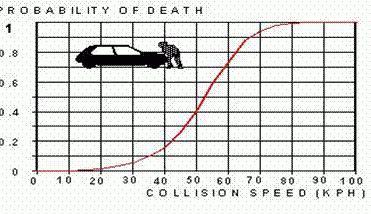No speed, no mass, and no protection
No speed, no mass, and no protection
Speed is a fundamental risk factor in traffic. Firstly, speed is related to crash rate [1]. From several studies of the relationship between speed and crash rate, we can conclude that higher absolute speeds of individual vehicles are related to an exponential increase in crash rate [31][32]. Secondly, speed is related to crash and injury severity. When the collision speed increases, the amount of energy that is released increases as well. Part of the energy will be 'absorbed' by the human body. However, the human body tolerates only a limited amount of external forces. When the amount of external forces exceeds the physical threshold, severe or fatal injury will occur. Hence, higher speeds result in more severe injury (see Speed and injury severity). This is particularly true for occupants of light vehicles, when colliding with more heavy vehicles, and for unprotected road users, such as pedestrians and cyclists when colliding with motorised vehicles.
Weight (mass) also plays a very prominent role in the outcome of crashes. When a heavy and a light vehicle collide, the occupants of light vehicles are far more at risk of sustaining severe injury [7]. This is because the energy that is released in the collision is mainly absorbed by the lighter vehicle. Pedestrians, cyclists and moped riders have the largest risk of severe injury when colliding with a motor vehicle. The difference in mass is huge and the collision energy is mainly absorbed by the lighter 'object'. In addition, pedestrians and cyclists are completely unprotected: no iron framework, no seatbelts, and no airbags to absorb part of the energy. For a collision between a car and a pedestrian, the following relationship between speed and survival chance was established by Ashton and Mackay (1979; cited in ETSC [19]):
| Car speed | % fatally injured pedestrians |
|---|---|
| 32 km/h | 5% |
| 48 km/h | 45% |
| 64 km/h | 85% |
In a graph, the probability of fatal injury for a pedestrian colliding with a vehicle looks like this (source: Pasanen, [37])

